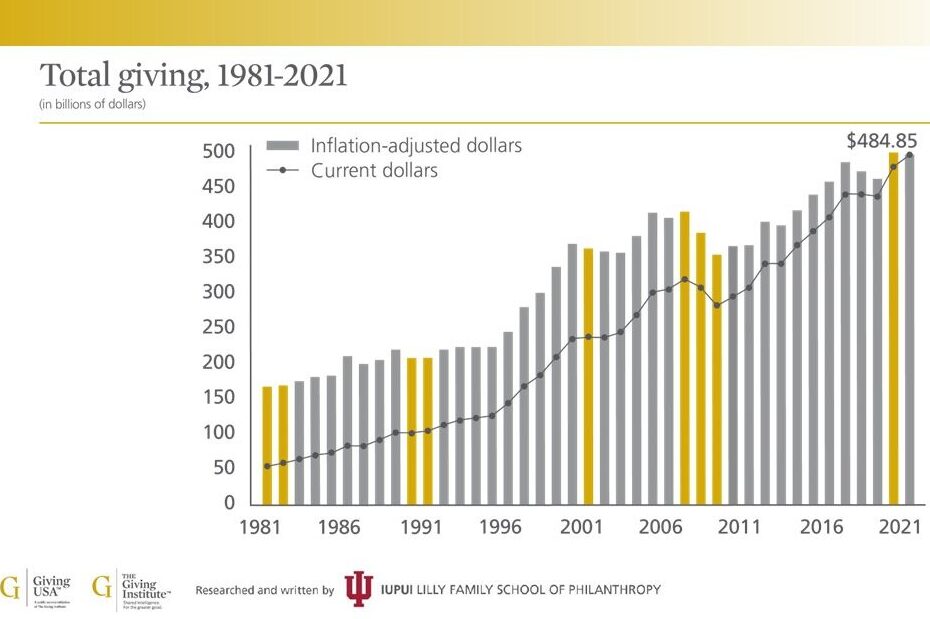Even with the continued challenges related to the unprecedented events of 2020, donors continued to give more generously in 2021 than before the pandemic. Multiple factors, including historic inflation, affected philanthropic choices, and many donors returned to supporting their favorite causes, with sectors that suffered in 2020 rebounding well. Though the landscape of giving looked rather different in 2021, it continued to grow, reaching the highest total in history.
Giving USA Foundation has released annual estimates of charitable giving for 2021, showing that giving reached more than $484.85 billion. Giving USA 2022: The Annual Report on Philanthropy for 2021 reports a fourth year of growth, with the highest total in history. Total giving reflects an increase of 4% in current dollars but stayed flat at -0.7% in inflation-adjusted dollars. Growth remains driven largely by individuals— supported by growth in foundation giving.
Three main topics influenced giving significantly: the COVID-19 pandemic, continuing racial and social justice movements, and one of the highest inflation rates in 40 years.
Giving by sources highlights the following key trends in 2021:
- Individuals gave 4.9% more than in 2020—but giving stayed flat when adjusting for inflation. At 67%, individuals remain the dominant giving source by far. Individuals also influence other sources of giving, such as family foundations, donor-advised funds, bequest gifts, and family-owned businesses.
- Foundation giving increased by 3.4% and held its previous share of 19% of all contributions in 2021. This total includes giving by independent, community, and operating foundations.Strong economic growth contributed to higher foundation and corporate giving in 2021.
- Bequest giving declined by 7.3% and comprised 9% of total contributions. Bequest giving is known to be volatile year-to-year, so the decrease in 2021 likely may be the result of some extraordinarily large bequests in 2020. Despite the decline, the total dollars given in 2021 were the second highest ever when adjusted for inflation.
- Corporate giving notably increased by 23.9% but comprised just 4% of all contributions. Corporate giving includes cash and in-kind contributions made through corporate giving programs and grants and gifts made by corporate foundations. This increase reflects the impact of the 10.1% growth of the US Gross Domestic Product as well as the large increase in corporate pre-tax profits in 2021. Both of these economic indicators are closely linked to corporate giving.
Giving to eight of nine charitable subsectors grew or stayed flat; Religion, Education, and Human Services remained the top three subsectors, receiving 54% of all contributions. Religion received 27%, Education received 14%, and Human Services received 13% of all contributions, with Giving to Grant-making Institutions just slightly lower than Human Services. Arts, Culture, and Humanities and Public-Society Benefit rose to the top in terms of growth over 2020, with increases of 27.5% and 23.5%, respectively. Education was the only subsector that declined, with a drop of 2.8%, but the sector shows growth of 13.2% over the past three years, in current dollars.
2022 Fundraising Recommendations
Reflecting on this new Giving USA data, our experiences with clients, and in context of the current environment, JGA recommends the following strategies to grow philanthropy.
- Focus on donor engagement: As the giving landscape evolves, there is no better time to connect with your current and future donors! We are all learning and adapting together, and donors and prospects will appreciate current news on your organization and in the field as a whole. Donors demonstrated a continued commitment to generosity in 2021 and will likely be receptive to conversations.
- Share impact stories: Never underestimate the power of a story. Donors and prospects want to hear how your organization is having an impact, thanks to generous donors. Be sure to mix it up with success stories from the past and current initiatives you have created to adapt to evolving needs. Share how philanthropy continues to make a difference even as specific needs and circumstances change.
- Embrace flexibility: It will be important to stay abreast of ongoing challenges like inflation, staffing shortages, increased demand, and supply chain issues, which arose in 2021 and continue to impact nonprofits today. Although the economy’s rebound from the pandemic boosted foundation and corporate giving, lasting effects on jobs, incomes, lifestyles, and financial priorities may have affected individual giving habits. Remain flexible and be able to suggest various ideas for methods and timing of giving depending on unique situations and donor preferences.
- Expect and prepare for changing preferences in giving: Donors are becoming more and more savvy in alternate ways of giving, such as Donor Advised Funds and cryptocurrency. Learn about these methods and work with interested donors to find solutions. For DAFs, consult the new GUSA chapter that was added to the report this year.
We encourage you to download a free copy of the Giving USA 2021 highlights or order your full copy of the report at givingusa.org.
Giving USA 2022: The Annual Report on Giving for 2021 is published by Giving USA Foundation, a public service initiative of The Giving Institute, and is the longest running and most comprehensive report on
